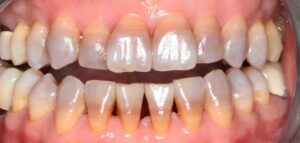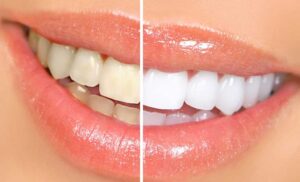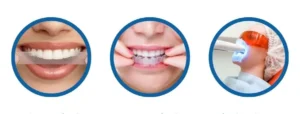Have you invested time and money in teeth whitening, only to be disappointed with the results? You’re not alone. Many individuals experience the frustration of teeth whitening not being white. If you’re also concerned about this issue, don’t miss the following article. Joy International Dental Clinic will shed light on the reasons why your teeth whitening efforts might be falling short and offer optimal solutions to help you achieve the radiant smile you’ve always desired.
Content of table
Toggle1. Unveiling the Culprits: Common Reasons for Ineffective Teeth Whitening
You’ve tried teeth whitening, but the results haven’t lived up to your expectations? You might be encountering one of the following reasons without even knowing it. Let’s delve deeper into these potential obstacles with Joy.
1.1 Teeth whitening not being white because Tetracycline

If your teeth were exposed to Tetracycline antibiotics during your childhood, there’s a high probability that your enamel is stained from within. This type of intrinsic staining is notoriously difficult to address, and even the most potent whitening agents may not yield satisfactory results. Because whitening products primarily target the outer surface of the teeth, they struggle to penetrate the deeper layers affected by Tetracycline. In such cases, alternative cosmetic solutions like porcelain veneers or composite veneers might be more suitable options.
1.2 Enamel Structure: A Natural Influence
Each individual possesses a unique enamel structure, and not everyone is blessed with the ideal enamel composition for effective teeth whitening. If your enamel is naturally thin or has been compromised due to factors like erosion or trauma, the underlying yellowish dentin layer may become more prominent, making it challenging to achieve a dazzling white smile. This inherent characteristic means that teeth whitening results can vary significantly from person to person.
1.3 Pre-Existing Dental Restorations: A Mismatch in Color

Did you know that dental materials like porcelain and composite resin don’t respond to bleaching agents in the same way as natural teeth? If you have dental restorations such as porcelain veneers, crowns, or composite fillings, these areas will retain their original color even after you undergo teeth whitening. This can lead to an uneven or patchy appearance, with the natural teeth appearing lighter than the restored areas. It’s crucial to consult with your dentist before pursuing teeth whitening to determine the best approach for your specific situation.
1.4 Inadequate Whitening Techniques: A Matter of Expertise

Not all teeth whitening methods are created equal. Utilizing incorrect techniques, employing insufficient concentrations of bleaching agents, or failing to tailor the treatment to your individual oral health needs can hinder the whitening process and prevent you from achieving your desired results. Even seemingly harmless at-home whitening kits can be ineffective or even detrimental if used without professional guidance.
1.5 Dietary Habits: The Stain-Inducing Culprits

Even after successful teeth whitening, maintaining your newfound brightness requires vigilance, particularly when it comes to your diet. If you continue to indulge in staining foods and beverages like coffee, tea, red wine, dark sodas, or richly colored sauces, your teeth will gradually revert to their previous shade. Especially in the initial days following a whitening treatment, your teeth are more susceptible to absorbing stains, making dietary modifications essential for preserving your radiant smile.
2. What to Do When Teeth Whitening Falls Short
Experiencing unsuccessful teeth whitening can be disheartening, but don’t despair! There are various approaches to address this issue, each tailored to specific circumstances. Consider the following recommendations:
- Identify the Root Cause: The first step is to pinpoint the underlying reason for the ineffective whitening. This will guide you toward the most appropriate solution and prevent you from wasting time and resources on methods that are unlikely to work.
- Seek Professional Evaluation: If you’ve exhausted various whitening options without success, it’s time to consult with a reputable dental professional. They can conduct a thorough examination of your teeth and recommend alternative cosmetic procedures like porcelain veneers or dental bonding to achieve your desired smile.
- Exercise Patience and Persistence: In some cases, particularly with long-standing stains or discoloration, achieving noticeable results may require patience and consistent effort. You might not see dramatic improvements after a single treatment, so it’s essential to follow your dentist’s instructions diligently and maintain a long-term approach.
- Pay Attention to Post-Whitening Care: After undergoing teeth whitening, your enamel will be more vulnerable to staining and sensitivity. It’s crucial to adopt a meticulous oral hygiene routine and avoid staining substances to prolong the effects of the treatment.
3. Preventive Measures: Habits to Avoid for Optimal Whitening Results

To maximize the success of your teeth whitening efforts and prevent future disappointments, consider incorporating the following habits into your daily routine:
- Dietary Modifications: Limit your consumption of staining foods and beverages, including coffee, tea, red wine, dark sodas, soy sauce, curry, and beets. These substances can gradually discolor your teeth and diminish the brightness achieved through whitening.
- Tobacco Cessation: Smoking or chewing tobacco not only poses significant health risks but also contributes to severe tooth discoloration. Quitting tobacco use is essential for maintaining a healthy and vibrant smile.
- Avoid Over-the-Counter Whitening Products: While readily available, over-the-counter whitening kits and products may not be as effective as professional treatments and can sometimes cause enamel damage or sensitivity if used improperly. It’s best to consult with your dentist before using any at-home whitening methods.
- Maintain Proper Oral Hygiene: Consistent and thorough oral hygiene practices are paramount for preventing staining and preserving your whitening results. Brush your teeth at least twice a day with a soft-bristled toothbrush and fluoride toothpaste, floss daily to remove plaque 1 from between your teeth, and use an antiseptic mouthwash to kill bacteria and freshen your breath.
Conclusion
If you’re struggling with ineffective teeth whitening, don’t lose hope. By identifying the underlying cause and seeking professional guidance, you can achieve the dazzling smile you’ve always envisioned. Joy International Dental Clinic is here to help you navigate the world of teeth whitening and find the perfect solution for your unique needs. Schedule a consultation with our experienced dental team today and take the first step toward a brighter, more confident you.






